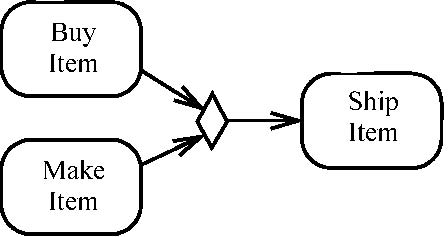12.3.36 MergeNode
A merge node is a control node that brings together multiple alternate flows. It is not used to synchronize concurrent flows
but to accept one among several alternate flows.
*Generalizations
•
ControlNode (from BasicActivities ) on page 371
*Description
A merge node has multiple incoming edges and a single outgoing edge.
*Attributes
No additional attributes
*Associations
No additional associations
*Constraints
[1] A merge node has one outgoing edge.
[2] The edges coming into and out of a merge node must be either all object flows or all control flows.
*Semantics
All tokens offered on incoming edges are offered to the outgoing edge. There is no synchronization of flows or joining of
tokens.
*Notation
The notation for a merge node is a diamond-shaped symbol, as illustrated on the left side of the figure below. In usage, however,
the merge node must have two or more edges entering it and a single activity edge leaving it. The functionality of merge node
and decision node can be combined by using the same node symbol, as illustrated at the right side of the figure below. This
case maps to a model containing a merge node with all the incoming edges shown in the diagram and one outgoing edge to a decision
node that has all the outgoing edges shown in the diagram. It assumes the UML 2.0 Diagram Interchange specification supports
the interchange of diagram elements and their mapping to model elements.
 Figure 12.105 - Merge node notation
Figure 12.105 - Merge node notation
*Examples
In the example below, either one or both of the behaviors, Buy Item or Make Item could have been invoked. As each completes,
control is passed to Ship Item. That is, if only one of Buy Item or Make Item completes, then Ship Item is invoked only once;
if both complete, Ship Item is invoked twice.

Figure 12.106 - Merge node example
Merge nodes are introduced to support bringing multiple flows together in activities. For example, if a decision is used after
a fork, the two flows coming out of the decision need to be merged into one before going to a join. Otherwise the join will
wait for both flows, only one of which will arrive.
*Changes from previous UML
Merge nodes replace the use of PseudoState with junction kind in UML 1.5 activity modeling.

